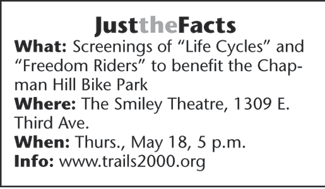|
| ||||||
| Downhill at Chapman SideStory: The Bike Park benefit
by Will Sands
Call it what you will – freeride, downhill or flow – gravity-based riding is one of the fastest growing segments of mountain biking. There are currently more than 30 “purpose-built” bike parks in the United State and Canada, and the parks do much more than mimic terrain found in nature. Via a series of gaps and stunts, they offer obstacles that challenge skills and stretch imaginations. They also bring millions of dollars into community coffers. The Chapman Hill Bike Park Project is a collaborative effort to round out Durango’s mountain bike offerings. Trails 2000, Fort Lewis College Cycling, DEVO, Durango BMX, Second Avenue Sports, Pedal the Peaks and various free riders are partnering in the push and have been meeting since 2007 to get the project going. “The group is committed to bringing additional types of riding to Durango,” said Mary Monroe, executive director of Trails 2000. “Gravity and flow trails are hugely popular in places like British Columbia and at resorts all over North America. We’re hoping to provide new riding opportunities in Durango for residents and visitors alike.” Colin Shadell is a Durango native and longtime bike racer who has been instrumental in the push for gravity riding in Durango. Like Monroe, he said that this mountain bike destination is in need of diversification. “We have awesome cross-country trails in Durango, but they’re all fairly similar,” he said. “A downhill trails network would be one more thing to enhance the overall mountain bike experience in Durango. Chapman Hill, which is home to the ice rink, municipal ski hill and a handful of existing bike trails, rose to the top of possible locations for a gravity park. The working group has laid out three flow trails ranging in difficulty from green (easy) to black (most difficult). The trails would begin on the Fort Lewis rim and meander down to the base. The idea is to provide a “continuous downhill experience” for all types of riders, complete with stunts, ladder bridges, table tops and gaps. In addition, a large pump track, permanent dual slalom course and commuter trail are envisioned as part of the proposal.
“Chapman’s a perfect place to do this given its central location, facilities and parking,” Monroe said. “We want to create an experience where anyone at any age can go out and work on technical skills like descending ladders and hitting jumps.” Alpine Bike Parks, a Whistler-based bike park and trail designer, has been brought on board to finalize the layout for the Chapman Bike Park, and so far, the City of Durango is smiling on the plan. The Parks and Recreation Advisory Board recently approved the project by unanimous vote. Next stop for the project will be a visit to the Durango Planning Commission and a community scoping meeting. Once the approvals are in place, the working group hopes to get a final plan from Alpine Bike Parks and break ground on the project next spring. “Hopefully we can throw extra time and funding at this thing and do it right the first time,” Shadell said. “If everything goes as planned, we could be riding by next summer.” Shadell added that another area is looking up for downhillers – work is scheduled to enhance the Log Chutes trail system this summer, which will offer other options to gravity riders. He said that his hope is that the offerings will bring freeriders out of the woods and into the mainstream of local cycling. “Chapman and Log Chutes are good places to get our start,” he said. “Our hope is that it will catch on, and that Purgatory can jump on and build a bike park one day. I know that I’m over traveling out of town to do most of my riding.” And Shadell is not the only one traveling to ride at bike parks. “Resort areas have found that they can bring a bunch of traffic by building trails that appeal to wide variety of riders and abilities,” Monroe said. “Given that we have an eight-month biking season in Durango, it only makes sense to round out our offerings.” •
|



 Durango mountain biking is on a downhill track, and that is a good thing. Though internationally renowned for its cross-country riding, Durango’s options for gravity-oriented cyclists remain limited. The Chapman Hill Bike Park project is a push to start to fill the downhill mountain biking void and provide new trail options for local and visiting riders.
Durango mountain biking is on a downhill track, and that is a good thing. Though internationally renowned for its cross-country riding, Durango’s options for gravity-oriented cyclists remain limited. The Chapman Hill Bike Park project is a push to start to fill the downhill mountain biking void and provide new trail options for local and visiting riders.
